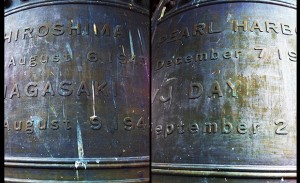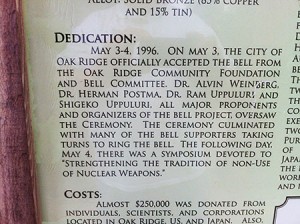Truman’s Hard Choice: Hiroshima 70 Years Ago Today
August 6, 2015 marks the 70th anniversary of the dropping of the first atomic bomb. It exploded over the Japanese city of Hiroshima in a mushroom cloud of destruction that shocked the world. With that event, humanity entered a new and frightening era.
Hiroshima did not just hasten the end of a terrible war — it put humanity in a very different place. Soon we possessed the ability to destroy civilization with the push of a button.
Physicist Robert Oppenheimer, immediately after the successful explosion of the first atomic test at Alamogordo, N.M., recited aloud from the Bhagavad-Gita: “Now I am become Death, the destroyer of worlds.” It was also Oppenheimer who cited the Prometheus legend, part of Western literature since the days of the Greeks, where the Titan-god steals fire and gives it (back) to a human race not quite able to handle it or the god-like powers that go with it.

Two different sides of the Japanese-American Friendship Bell in Oak Ridge, Tennessee. Put up in 1996, the bell is a reminder of what each nation suffered but also of the hope for true, enduring peace between Japan and the United States.
Perhaps because this is the 70th year, people will try even harder to figure out how to manage the nuclear genie, long out of the bottle, whether it be in Iran, North Korea, Russia, or even in our own country. And some will blame the United States not only for the first use of nuclear weapons, but for the development of nuclear weaponry in the first place — and especially for maintaining its nuclear arsenal.
Few will mention the fact that, following the creation of the atom bomb and after centuries of devastating warfare in Europe, including two horrific world wars in the first half of the 20th Century, Europe has now gone 70 years without another major war.
Also rarely mentioned is the fact that the Soviet Union, after greedily expanding into Eastern Europe and gobbling up as much territory as possible after the fall of Berlin, basically stopped its battle-hardened troops and stayed put. Remember, at the end of hostilities in Europe the Soviets had a 4:1 superiority in men and a 2:1 superiority in tanks over the Western Allies in Europe. Something held the Soviets at bay.
Thus, it is entirely possible that nuclear “deterrence” played a major part in protecting the West sooner than many realize. When President Truman issued the Truman Doctrine in 1947, he certainly believed the growing US nuclear arsenal gave him the clout to keep Stalin and other dictators in check.
Nevertheless many argue that not only should America not have been the first to use nuclear weapons (among them General Dwight Eisenhower), but that it was immoral to have developed them in the first place, and immoral to keep them.
To better assess that position, let’s look at how it all unfolded.
In October of 1939, shortly after Germany invaded Poland and began World War II, a letter arrived in President Franklin D. Roosevelt’s office. It was signed by Albert Einstein. It began like this:
Sir:
Some recent work by E. Fermi and L. Szilard, which has been communicated to me in manuscript, leads me to expect that the element uranium may be turned into a new and important source of energy in the immediate future. Certain aspects of the situation which has arisen seem to call for watchfulness and, if necessary, quick action on the part of the administration.
The scientists who wrote the letter and got Einstein’s help in getting it to Washington (mostly Szilard, an exiled Hungarian nuclear physicist) went on in the note to warn the president that Germany, which had annexed Czechoslovakia in 1938, had suddenly “… stopped the sale of uranium from Czechoslovakian coal mines.”
Szilard and Fermi, now doing research in the U.S., knew exactly what that meant. The process of uranium fission had been discovered the previous December in Berlin by Otto Hahn. Szilard himself had proposed that a chain reaction in enriched uranium would lead to a massive release of energy, due to the action of the neutrons involved. What was initially an exciting discovery, celebrated by physicists around the world, suddenly became a priority for the Third Reich to develop into military technology. (Hahn, it should be noted, never participated in weapons research in Germany, and was on the brink of despair when he learned of the dropping of the atomic bomb on Hiroshima.)
In a real sense, the genie was already out of the bottle by this point. Scientists worldwide knew what uranium fission could do. The race was on. The world had entered the nuclear age. The rest was a matter of who could develop it the quickest.

Many of the leading scientists in American nuclear research participated in the dedication of the Friendship Bell Plaza in Oak Ridge, Tn.
The British considered it, but the truth was that producing sufficient quantities of HEU (Highly Enriched Uranium) would take one of the most massive industrialization efforts the world has ever seen, and they knew it. America was to be the place and The Manhattan Project was the name. It would need all the tremendous resources and ingenuity of American industry and craftsmanship to succeed.
Beginning in 1943, construction was begun in a remote area of East Tennessee (later named Oak Ridge) and Hanford, Washington, to produce the first working reactors and gigantic uranium and plutonium processing plants. The Graphite Reactor in Oak Ridge, the world’s first continuously working reactor, proved the concepts behind the production of plutonium that would soon be implemented in Hanford.
The Y-12 plant in Oak Ridge, using giant electromagnets made from silver borrowed from the U.S. Mint, produced enough HEU for the “Little Boy” uranium bomb. The Hanford site, meanwhile, produced the plutonium test bomb exploded at Alamogordo, as well as the plutonium bomb that would be used on Nagasaki. Shortly thereafter, the K-25 plant was finished at Oak Ridge, where gaseous diffusion and centrifuges proved the fastest and most economical means to build up the new US nuclear arsenal.
Through this massive effort, conducted at rush speed in largely hidden, secret cities, the United States won the race. It turned out that Germany was not as close as many thought to getting the bomb, but the Soviet effort, though small, was making rapid strides, aided by spies embedded in US and British research facilities.
The decision whether and how to use the bomb fell to President Truman. His decision, which he characterized as doing “the right thing” has been criticized from the beginning. Many were aghast at the number of civilian casualties. One thing that often goes overlooked is that the United States was already firebombing Japanese cities, trying to force the Japanese to surrender. A March 10, 1945 firebombing raid on Tokyo killed 105,000 in that one night alone. Robert McNamara, (JFK’s Secretary of Defense) later documented that 67 Japanese cities were firebombed by the US in World War II. Many of these cities were 60% or more destroyed.
Even in the face of this relentless campaign of firebombings, the Japanese were unwilling to surrender. A land invasion of the Japan seemed all but unavoidable. American soldiers had learned the hard way how tenaciously the Japanese fought for the outlying islands. How much more fiercely would they fight for Japan itself? Estimates put the number of American casualties as high as half a million for a land invasion, and many times more in Japanese civilian and military casualties.
Truman and his advisers felt the shock of the new super-weapon would cause Japan to give up, if it was used directly on the Japanese people. The Japanese did not surrender after the first bomb was dropped over Hiroshima. They did after the second one was dropped on Nagasaki three days later.
Whether the Japanese would have surrendered soon without the bomb being dropped, or the Soviets would have felt compelled to restrain their ambitions, will be long debated. Once thing is certain: atomic energy was coming and someone would weaponize it. The United States got there first and because of that, the balance of power in a war-weary world was shifted in America’s favor. As frightening as the nuclear “dagger” is, I am certain that it worked out far better for the world in American hands in the early years than it would have in other hands. The world is not a safer place if we pretend that the spirit of global tyranny and conquest will magically disappear if we abandon our position of global leadership.
The deaths of tens of thousands of civilians in Hiroshima was a great tragedy, but so was the bombing of a thousand other cities by all sides and the deaths of approximately 50 million civilians due to war-related causes in World War II. An axis of great evil had to be stopped, and was.
The biblical teaching that governments and national authorities are in place to protect their people and to “exercise wrath on the wrongdoer” (Romans 13:4) holds true whether or not the work and sacrifice of our military remains fashionable among those who enjoy its fruits. Thoughtful Christians will differ on the degree that enemy civilians should be put in harm’s way in pursuit of victory over an evil enemy and the cessation of war. But it’s one thing to grapple over where that line rests. It’s another to fall over into a thorough-going pacifism at odds with both the biblical witness and the Christian tradition.
The Judeo-Christian worldview does not cling to the vain hope that people or even nations will mend themselves through some utopian world-order scheme. To the contrary, bathed in a biblical understanding of the true nature of humanity, it holds the doctrine of deterrence and just war as a last resort to stop global evil.


